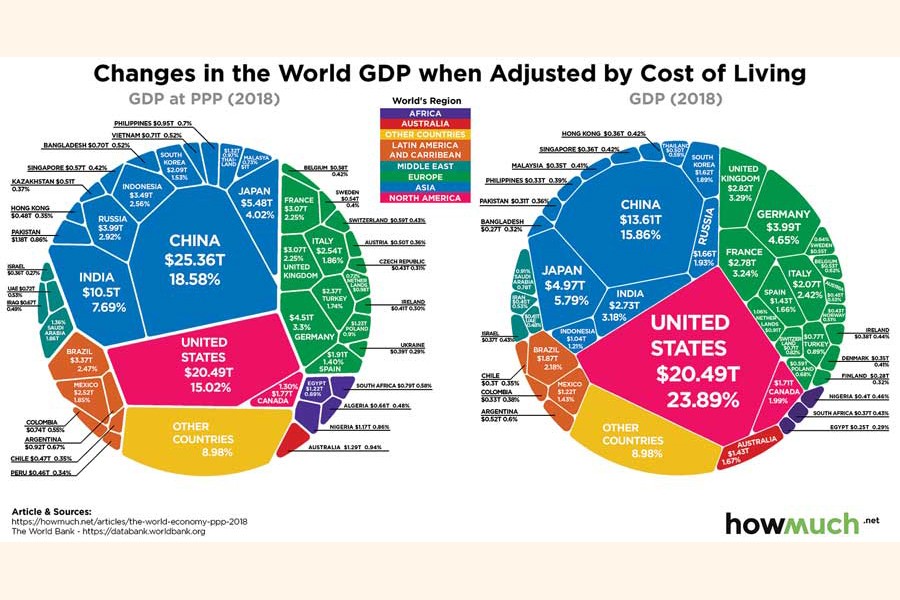
Geo-economics and economic security
Salehuddin Ahmed | Wednesday, 13 November 2019

 The concept of national security was mostly developed in the US after the World War II. Its initial focus on military might now encompasses a broad range of issues such as economic security, energy security, environment security and non-traditional security concerns. After the end of the Cold War, the attitude shifted profoundly and economic security has assumed a central role.
The concept of national security was mostly developed in the US after the World War II. Its initial focus on military might now encompasses a broad range of issues such as economic security, energy security, environment security and non-traditional security concerns. After the end of the Cold War, the attitude shifted profoundly and economic security has assumed a central role.
Economic interdependence among countries is woven by geo-economics. Driven by the spirit of sovereignty, each country also has security imperatives within a rapidly changing geopolitics. National security deals with survival of a state through use of political power, economic power, diplomacy, international trade and business. This article will deal mainly with geo-economics and economic security with special reference to Bangladesh.
Geo-economics aspects are driven by individual investors and firms seeking benefits from globalisation, regional integration and international business. Since the end of the Cold War, a market economy like Bangladesh is characterised by international trade, multilateral agreements, multinational corporations, choices of the governments, stakeholders, and consumers, for the essence of economic security. It is argued that because of lacking economic security or a viable market-based economy, the Union of Soviet Socialist Republic disintegrated.
The global financial and economic crisis started in 2007 as an aftermath of the housing sector bubble coupled with aggressive lending practices in the US sub-prime mortgage market and lax regulation of the financial sector. To start with, these developments affected the companies holding mortgage-backed securities and credit derivatives. The early signs of the crisis were evident in 2007; but the financial crisis developed into a full-blown global recession in late 2008 battered by continuous deepening and widening of the crisis. The recession created shockwaves through the global financial system and the global economy, and the advanced economies were affected most. The governments in these countries are bracing their financial sector and the real economy by stepping up various policy measures including injecting huge sums of money for bailing out the ailing financial institutions and other industries. What is worst is that the recession appears to hang on throughout 2014.
The makings of the crisis were essentially in the US imbalances exported to the rest of the world, over the last couple of decades or so, in the form of persistent current account deficits. The position of US dollar as the dominant global reserve currency enabled the US to pursue lax macroeconomic policies indefinitely, with its deficits financed externally by economies running surpluses. Not since the beating down of US inflation in the 1980s by the US Fed under Paul Volcker at substantial pain of a domestic recession has the US opted again for domestic adjustments to correct imbalances; nor unlike the EU, has the US committed itself unequivocally to pursuing balanced policies (fiscal accounts were in balance in the Clinton era but private sector deficit unrestrained, and in the subsequent Bush era deficits of both public and private sectors ran amok).
In the lax US monetary and fiscal policy regime the surfeit of cheap liquidity surged in several aberrant directions chasing higher returns; into speculation creating commodity and asset price bubbles (the incipient US house price bubble at the turn of the century actually eased the pains from the dotcom bubble burst), into equity buybacks with reckless leveraging (improving return on equity but worsening the fragility of corporate finance), into loans to borrowers of dubious credit and securities backed thereby, into derivatives of inscrutable complexity concealing the riskiness of the underlying assets. Close global integration transmitted these trends of the US financial markets and institutions quickly to the other open economies, including those pursuing balanced policies. Also, the laxities of US monetary policies immediately and automatically surfaced in the economies with currencies pegged to US dollar, including the Middle Eastern oil exporters. The surging wealth from price bubbles in commodities and assets flowed not into combating global poverty, environmental degradation or climate change; but largely into hedonism of private jets, yachts, mansions and other indulgences including such whimsical, fanciful pursuits as competition in mega scale fairytale-like construction projects, artificial islets curved in the Gulf with coastlines alien to known laws of hydrodynamics, mega dollar artworks like golden lamb and Kate Moss gold statue. Now the whole fantasy structure faces collapse as popping price bubbles triggered chains of debt default, paralysing markets with freeze up of fresh lending to refinance maturing debts.
Small economies like Bangladesh are however by no means invulnerable to fallouts from prolonged global downturns or to negative spillovers of policies of large economies, and therefore have strong stake in global stability. In forums like G-20 they need to argue forcefully for the same high priority to stability as to recovery; and also for stability action agenda going beyond addressing symptoms (lapses in risk managements, inadequacies of regulation and supervision) to addressing the underlying cause (lax policies allowing unbridled liquidity expansion, incubating bubbles).
A safe path of global balance and stability will be a lot easier if global liquidity growth is tied to the growth of real global output in some mechanism that injects and withdraws liquidity counter-cyclically as global real output growth slackens or paces up. The IMF (reformed with appropriately rebalanced voting rights and quotas for member economies) can be mandated to craft and administer the tying mechanism, in a new role somewhat as the apex global monetary agency.
Consensus building for such a new mechanism (in broad likeness of gold standard, with real global output substituting for gold) may be arduous, all the more reason for kicking off the consultation processes at the soonest possible.
Significant gain in global financial stability can be expected also from reforms limiting excessive leverage in corporate finance. In the current crisis the high fragility brought about by reckless substitution of equity with debt precipitated extended chains of debt defaults, paralising financial markets across major economies. A corporate generally favours debt over equity because debt servicing costs are tax deductible while income on equity is subject to taxation. However, in downturns, debt burden deepens a firm's financial distress, even inviting demise, as made amply evident by the global financial crisis.
The Bank for International Settlement (BIS) in Basel, Switzerland, for some years is engaged in developing global norms of capital adequacy for banks and financial institutions. BIS can also be mandated to develop global norms of debt equity balance and sound practices in corporate financing, limiting tendencies of excessive leveraging. To this end, some extent of tax break on income from equity, narrowing the gap in relative attractiveness of debt and equity as financing option, may also be well worth considering.
Economic cooperation and national security
Bangladesh has a unique geopolitical location in South Asia; its economy is greatly influential by two big economic powers - China and India. While a vast amount of trade is with India and China, the global partners in Europe and the USA also influence Bangladesh's major exports, the readymade garments (RMG). Besides these camps, Bangladesh has connection with Arab and Middle East countries for its manpower export. Bangladesh ranks the 9th amongst top 10 remittance recipient developing countries (US$8.9 billion in 2008), India is the top (US $30 billion) and China the second highest recipient (US $27 billion). However, since 2010 Bangladesh has been facing reduced overseas employment and stagnant remittances inflow. There are reasons to worry.
Global and regional cooperation and economic integration are dependent on the following realities of Bangladesh:
a. Location, relative situation and boundary,
b. Size of the country: 144 thousand square kilometres
c. Form and physical feature
d. Climate and environment
e. Natural and other resources
f. Population characteristics
g. Economic resources (human, infrastructures etc)
h. Politics, education, values and cultures.
The above realities have bearing upon the national security implications of Bangladesh.
Global and regional cooperation and economic integration are dependent on geographical location of a country that includes Bangladesh. South Asia Association for Regional Cooperation (SAARC) has been formed to foster economic cooperation amongst eight (08) South Asian countries. However, this network has not emerged as another body like ASEAN did as a strong network-based institution. Bangladesh-India connectivity has the potential to forge linkage with Myanmar and China. The Economic Corridor consisting of Bangladesh, India, China, and Myanmar (BCIM) is still in the initial stage. China and India are gradually showing interests in BIMSTEC (Bangladesh, India, Myanmar, Sri Lanka, Thailand economic cooperation). The Bay of Bengal has assumed a strategic hub connecting the Indian and the Pacific Oceans, Japan and China. The big challenge for Bangladesh is to maximise leverage of their geo-strategic locations in the Bay of Bengal for exploring off-shore oil and gas reserves, and pursuing maritime interests. The traditional "Silk Route" from China to the Mediterranean basically dealt with commodities only, while the new concept of economic corridor and integration combines commodities with energy (oil, electricity, gas) resources, the so-called "Energy Route". Bangladesh may become vulnerable, in such a scenario if security concerns are not adequately addressed, especially when the big countries like China, India and the US are showing interests in the maritime areas near Bangladesh and beyond.
Some specific issues for Bangladesh
The following issues are relevant for Bangladesh to ensure its socio-economic progress and security:
a) Trade relations (with neighbours and beyond)
b) Investment (FDI and FPI, Multilateral and bilateral credit)
c) Border security
d) Transit facilities
e) Terrorism
f) Water sharing
g) Significance of the Bay of Bengal
h) Rohingya crisis
Let me try to give some holistic concept of national security. Harvard Professor Charles Maier (1990) defines:
"National security… is best described as a capacity to control those domestic and foreign conditions that public opinion of a given community believes necessary to enjoy its own self-determination on autonomy, prosperity and well-being". Some writers view national security in a societal "systems" context. In this approach national security and national strength are viewed as two interrelated issues.
Ronis (1997) states, "A part of being strong includes the strength of our nation's infrastructure; the foundation upon which the continuation of the continuous growth of our society depends. This includes its strong societal and moral codes, the rule of law, stable governmental and political institutions, schools and educational programmes to ensure a knowledgeable citizenry and life-long learning."
A serious challenge facing an emerging economy like Bangladesh is the growing concern relating to national resource constraints, especially land and water which cannot be easily solved, by technological solutions and cannot be augmented by trade (Kapur & Suri, 2012). What we need is 'true' spirit of globalisation and international cooperation, not rhetoric. The recent "Brexit Victory" possibly shows that the task is very complex and difficult.
Dr. Salehuddin Ahmed is a former Governor of Bangladesh Bank and Professor at Business School of BRAC University.
[email protected]